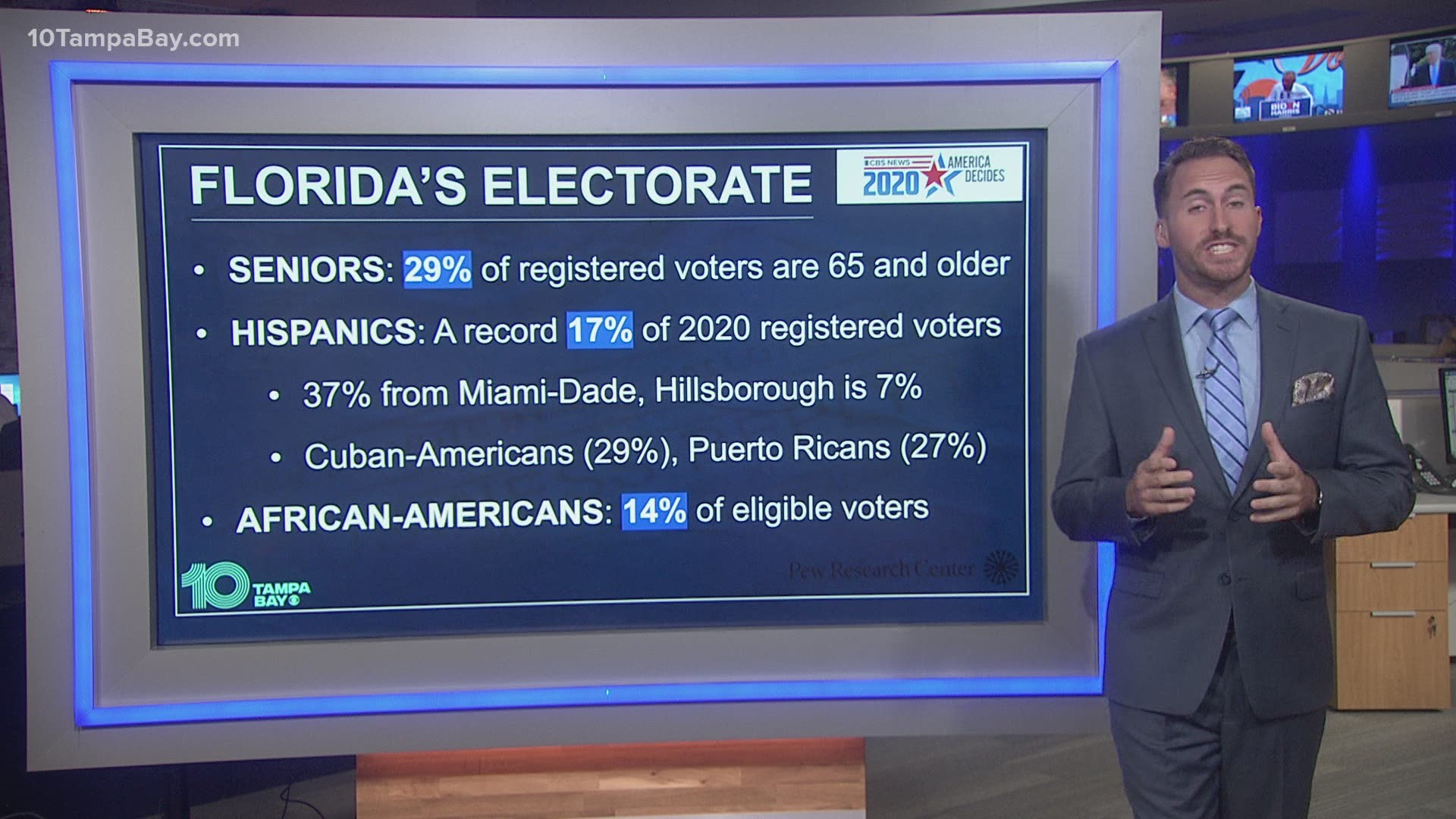ST. PETERSBURG, Fla. — Florida has everything imaginable.
Beautiful beaches and beautiful people – a mix of paradise and pageantry. It’s also the perfect backdrop for political theatre on the first Tuesday of November every election season.
2020 is no different.
The Sunshine State, and its 29 electoral college votes, has become the all-important battleground for the road to the White House. Since 1996, Florida’s margin of victory has been 2.6 percent, the smallest of any state in the country, so whether it’s reelecting President Donald Trump for another four years, or Democratic nominee and former Vice President Joe Biden supplanting him – truly, every vote matters.
“We saw it be razor-thin in 2016 with only 113,000 votes separating,” said Dr. Lars Hafner, a 10 Tampa Bay political analyst, “so these different demographic groups we look at, whether they’re small or large, can really make a difference.”
Those groups are what makes Florida so special and diverse. We’re filled with seniors and retirees, Hispanics and Latino transplants, millennials and African-Americans, white men and suburban women. Come one, come all.
It’s also what makes us so difficult to predict when it comes to elections.
One of the most important voter populations in Florida is, without a doubt, seniors. More than a fourth of our eligible voters are 65 or older, which is why The Villages in Sumter County becomes such a hotspot during campaign season.
In 2016, seniors backed Trump heavily, but recent polling shows Biden cutting into that support, largely due to the COVID-19 pandemic. In Florida, 82 percent of the state’s coronavirus-related deaths have come from people 65 and up.
“When you look at Florida over the decades, it’s the seniors who do vote,” Hafner said. “They are the ones who come to the polls and you can count on them more than any other demographic group to vote in Florida…recent polling shows Biden has taken a bigger slice of the senior vote. A lot of that has to do with how Trump has handled the virus.”
From Sarasota to St. Lucie, we’re flooded with retirees ready to kick back – and vote.
“We get the reinforcements from all over the country, as people come here to retire. That can impact our demographics, in terms of our vote….that may in itself explain why we’re such a purple state,” said Ciara Torres-Spelliscy, a law professor at Stetson University. “We get these infusions of all the transplants who bring their political views with them.”
But Florida wouldn’t be Florida without our large Hispanic population, whether it’s in Miami-Dade or Orange County.
Pew Research Center found that Latinos make up a record 17 percent of Florida’s eligible voters in 2020, up about 500,000 votes from four years ago. A majority of that is from Cuban-Americans and Puerto Ricans, who could swing our state red or blue.
“What’s interesting about the Florida Hispanic population is the Cuban-Americans tend to skew Republican, but not all of them,” Torres-Spelliscy said. “The Puerto Rican population skews Democratic, but then again, not all of them…the complication with the Latino vote is that it doesn’t fit into the normal partisan silos that we’re so used to. If you have a message that you think is going to appeal to Latinos – good luck. There’s such a variety of experiences and with politics over generations.”
Then there are the pockets of African-American voters throughout the state, which make up 14 percent of our electorate. Mix in the rural regions of the panhandle, predominantly white and wealthy Southwest Florida and the critical margins of the Interstate 4 corridor – and Florida has everything you could want.
“It’s all a game of get-out-the-vote at this point,” Torres-Spelliscy said. “I’ve been very encouraged by the long lines in that it shows how much voters care about voting. I’m not so thrilled about the long lines from an election administration point of view. I think we should be better at this by now, but it is what it is.
“Better to have a high turnout election.”

